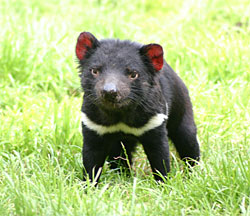Sunday, March 18, 2007
Verge of Extinction: Tasmanian Devil

The Tasmanian Devil, a rare carnivorous marsupial found only on Australia's southern island state of Tasmania, faces extinction in 10 to 20 years without a cure for the facial cancer now decimating the population. With half the population now wiped out, leaving less than 75,000 devils, Professor Hamish McCallum at the University of Tasmania is battling to establish offshore colonies of healthy devils. "We might be looking at a 10-15 year cap down to extinction," McCallum told Reuters in an interview. Nobody knows how many of the rapidly diminishing devils are left, but McCallum says the minimum would be 20,000.
Reuters, CNN
Grotesque sight
The devils usually have a life expectancy of about five years, but it is now unusual to see an animal over the age of three. Researchers estimate the wild population has fallen from 140,000 in the 1990s to 80,000.
A severely diseased devil is a grotesque sight: large tumours protrude from the face and neck, sometimes pushing out teeth and invading eye sockets. 
As the tumours interfere with feeding, the animals become emaciated and usually die within six months of showing lesions.
But while many scientists had suspected a virus, Anne-Marie Pearse, a researcher for the state of Tasmania who co-wrote the article in Nature, found abnormalities in the chromosomes of the cancer cells were the same in every tumor.
Pearse and her colleague Kate Swift discovered that, while the normal complement of chromosomes in the devil is 14, the tumours contained 13, which were grossly abnormal. These chromosomal rearrangements were identical in tumours from all 11 animals studied by the scientists.
Single source
This offers support for the idea that the disease apparently began with a single sick devil, probably in the mid-1990s, that directly spread the cancer cells by biting other animals. The authors propose that cancer cells are dislodged from one animal and essentially transplanted to another as a result of bites inflicted around the mouth.
"Devils jaw wrestle and bite each other a lot, usually in the face and around the mouth, and bits of tumor break off one devil and stick in the wounds of another," said Ms Pearse.
"We've found out how the disease is transmitted, which is a breakthrough in how we manage the wildlife population.
She added: "Finding a vaccine would be the ultimate goal."
The only other such cancer has occurred in dogs but, unlike the devils' disease, it could be overcome by the canine immune system.
The authors suggest that close kinship and low genetic diversity among Tasmanian devils reduces their immune response to transplanted cancer cells, making it more likely that they will take hold.
University of Tasmania pathologist Professor Conrad Muller, who specialises in cancer and immunology research, said it was too early to tell what the ramifications of the discovery would be.
"It certainly will attract a lot of interest because the devils have been dying out across the state," Professor Muller said.
"If the tumors are all common, then one potential approach would be some sort of vaccine therapy."
Labels: life threatening extinction, Tasmanian Devil, viral cancer
